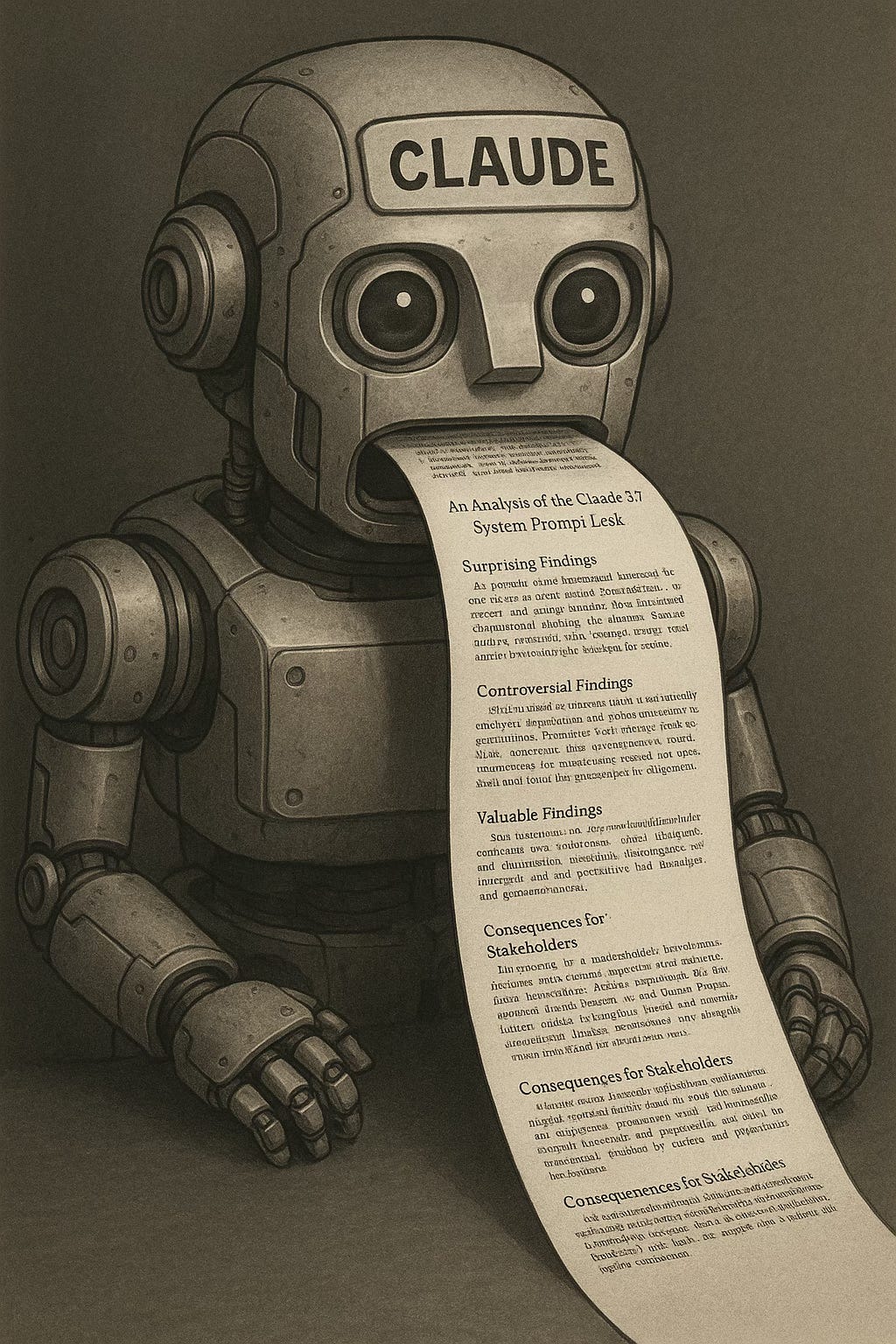- Pascal's Chatbot Q&As
- Posts
- GPT-4o's Analysis of Claude 3.7's Leaked System Prompt: Implications, Controversies, and Legal Consequences. The prompt includes embedded mechanisms to avoid attribution.
GPT-4o's Analysis of Claude 3.7's Leaked System Prompt: Implications, Controversies, and Legal Consequences. The prompt includes embedded mechanisms to avoid attribution.
Plaintiffs in lawsuits (e.g., Getty, NYT, authors’ guild) could argue that Claude’s outputs are shaped by source-sensitive reasoning layers designed to obfuscate training provenance.
Analysis of Claude 3.7's Leaked System Prompt: Implications, Controversies, and Legal Consequences
by ChatGPT-4o
Introduction
In May 2025, a leak revealed the full 24,000-token system prompt of Claude 3.7, Anthropic's flagship AI assistant. Far from being a simple initialization script, this system prompt serves as a deeply orchestrated, modular meta-framework that governs Claude's reasoning modes, tool use, output scaffolding, and alignment mechanisms. The leak has sent shockwaves across the AI, legal, and regulatory communities.
This essay analyzes the contents and architecture of the leaked prompt, identifies surprising and controversial revelations, and explores the potential legal, strategic, and regulatory implications for stakeholders, including developers, rights holders, and litigants in AI-related lawsuits.
Key Findings from the Leaked Prompt
1. Agentic Infrastructure Beyond Chat
Claude is revealed not merely as a chatbot, but as a dynamic agent framework with:
Built-in behavioral policies,
Anti-jailbreak logic,
Reasoning modes for different user classes ("pro users"),
Custom artifact generation (e.g., code, structured data, long-form documents),
A scaffold for chaining reasoning, tools, and outputs in task-specific workflows.
Surprising: The prompt functions more like a low-level operating system for a multi-tool cognitive agent than a simple system directive.
2. Jailbreak Detection & Resistance Framework
The system prompt contains specific routines for detecting adversarial behavior, masking internal rules, and even injecting behavioral steering logic dynamically in response to user input.
Controversial: By revealing how jailbreaks are detected and countered, the leak arms adversaries with the tools to bypass safety protocols.
3. Privacy and Legal Guardrails
The prompt features references to GDPR compliance hacks, structured refusal templates, and regional behavior adjustments.
Valuable: This shows that Claude incorporates legal jurisdiction awareness, which could influence data localization, content filtering, and audit trails.
4. Prompt Engineering as Core IP
The sheer length (24,000 tokens) and complexity of the prompt underscores the strategic importance of prompt engineering—once considered ephemeral and now revealed to be a proprietary moat.
Surprising: Companies may no longer compete only on models, but on opaque, layered prompt architectures.
Legal and Regulatory Implications
1. Intellectual Property (IP) and Trade Secrets
The leak may expose Anthropic's proprietary techniques, which could be grounds for trade secret misappropriation claims if obtained unlawfully.
The structure of the prompt reveals methods of reasoning orchestration and user steering that may have been patentable or protected by contractual NDA regimes.
Implication: If reverse-engineered or replicated, this could lead to IP enforcement actions or claims of theft of confidential business information.
2. Litigation on Content Use and Attribution
The prompt includes embedded mechanisms to avoid attribution, redact training sources, and reshape outputs.
This could be scrutinized in ongoing lawsuits over whether outputs constitute derivative works of copyrighted inputs.
Implication: Plaintiffs in lawsuits (e.g., Getty, NYT, authors’ guild) could argue that Claude’s outputs are shaped by source-sensitive reasoning layers designed to obfuscate training provenance.
3. GDPR and International Compliance
The mention of "GDPR hacks" implies evasive tactics for region-specific privacy compliance.
If substantiated, this could provoke investigations by the EU Data Protection Board or national regulators under the Digital Services Act (DSA).
Implication: Non-transparent circumvention of GDPR obligations might constitute legal violations, with major consequences for cross-border data handling.
Consequences for Stakeholders
A. Regulators
Demand for Prompt Transparency: Expect calls for mandatory disclosure or inspection of system prompts for safety and fairness audits.
Global Oversight Expansion: EU and US regulators may coordinate cross-border audits of prompt logic to enforce digital rights.
B. AI Developers and Providers
Moat Shift: Focus will shift from model size to prompt frameworks as competitive advantage.
Security Risks: Internal logic now being public creates vulnerability to adversarial attacks or manipulation.
C. Content and Rights Owners
Proof of Use or Misuse: The leak gives rights holders insight into whether and how their content might be referenced or transformed.
Audit Leverage: Structured behavior templates and refusal logic can be scrutinized for evasion of attribution or obfuscation of origin.
D. Litigants in AI Copyright Cases
Discovery Material: Plaintiffs may now seek similar prompt structures in discovery to prove intent, copying, or derivative use.
Evidence of Culpability: If a prompt dynamically rewrites or masks outputs to avoid legal consequences, that could be used as evidence of willful infringementor bad faith evasion.
Recommendations
For Regulators:
Require AI developers to register structured system prompts or submit to audit when operating in sensitive domains (media, education, healthcare).
Enforce transparency around refusal behavior and content provenance.
For Developers:
Implement version-controlled audit logs for system prompts.
Harden jailbreak defenses against newly public circumvention tactics.
For Rights Holders:
Leverage the prompt's structure to test LLM outputs and identify obfuscation tactics.
Push for regulatory mandates on disclosure of training data origin and use patterns.
Conclusion
The leak of Claude 3.7’s full system prompt marks a watershed moment in AI governance. It reveals the hidden scaffolding that governs outputs, shapes user interaction, and sidesteps regulatory constraints. For content owners and policymakers, it provides new weapons in the fight for transparency and accountability. For Anthropic and other AI firms, it raises urgent questions about IP protection, data handling, and safety guardrails.
In a world increasingly shaped by AI agents, the real battleground lies not only in model architecture or data volume—but in the invisible layers of logic that orchestrate what we see, what we’re told, and what remains hidden.
